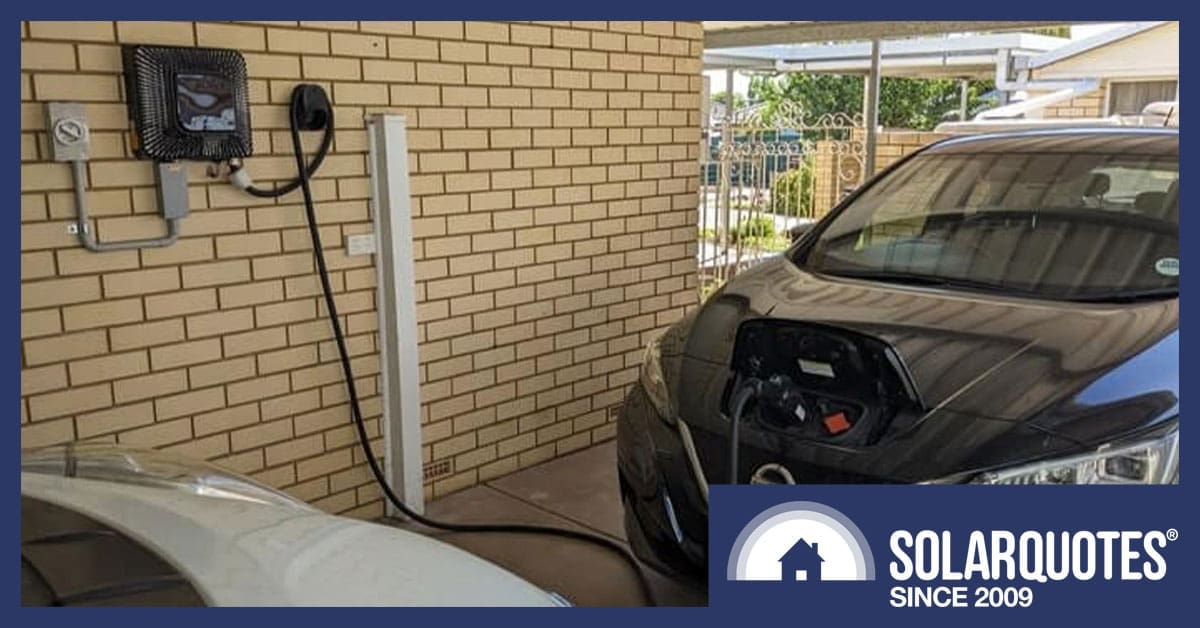
Bidirectional charging has long been the white whale of electric vehicle owners in Australia, and at long last ARENA has released a chart revealing where this elusive leviathan of energy storage can be found.
The National Roadmap for Bidirectional EV Charging, commissioned by ARENA and the RACE for 2030 Cooperative Research Centre, details what governments and industry need to do so Australians can use their EV batteries to power their homes and feed into the broader energy grid.
The report found that international suppliers of bidirectional charging products have been dissuaded by Australia’s jumble of network connection policies and smart-grid integration architectures that are “novel, opaque and jurisdictionally fragmented”.
ARENA CEO Darren Miller said:
“By the early 2030s, the battery capacity of our electric vehicle fleet is projected to outstrip all other forms of energy storage in the National Electricity Market. With estimates suggesting 1.5 million EVs on Australian roads by 2030, even 10% of those adopting V2G could meet 37% of the NEM’s total storage needs while also giving Australians control over their contribution to the clean energy transition.”
Circle These Five Points on The Map
The roadmap highlights five key action areas for Australia to get moving on bidirectional charging:
- A national policy commitment to send an unequivocal signal to local and international stakeholders that Australian
governments will proactively support EV charging products and services; - Time-limited installation rebates to catalyse the supply of bidirectional charging products and services to enable early market deployment;
- National Electricity Rule changes requiring all networks to offer dynamic network pricing products to willing customers in relevant areas;
- Clear direction on interoperability standards to enable efficient business and consumer investment;
- Clarity on the national smart grid.
Three Different Ways to Harvest Your EV Battery
The report acknowledges three forms of bidirectional charging:
- Vehicle to Grid (V2G) – EVs supply power to a mains electrical circuit that is electrically connected to the grid;
- Vehicle to Homes and Buildings (V2H/B) – EVs supply power to local electrical distribution system that is electrically separated from the grid, such as off-grid or during a power outage;
- Vehicle to Load (V2L) – EVs that supply power directly to one or more electrical appliances.
If you want a more detailed explainer, take a look at our breakdown of V2G, V2H and V2L.
The roadmap’s stakeholders found that Australia’s estimated 300,000 V2G capable EVs by 2030 represent the highest-value and most scalable application, with residential use likely to dominate. They did not recommend bidirectional charging capability for public charging equipment at this stage.
A Lucrative Bounty
Stakeholders consulted for the plan identified four key value streams:
- Energy arbitrage – the ability to discharge energy during periods of high energy prices, benefiting all consumers by reducing power system requirements for large-scale generation and storage.
- Network support – making the most of excess daytime solar production by charging during the day and discharging during extreme demand peaks, reducing network prices for all.
- Alternative power supply – EVs can work as a mobile power generator during grid outages, so can provide generation capacity in scenarios such as in the wake of a natural disaster.
- Frequency response – bidirectional charging in ISO 15118-20 ‘dynamic mode’ is capable of providing very fast frequency response, however the market for these services is considered to be relatively shallow and easily saturated by alternatives.
CHAdeMO Users Stranded At Sea
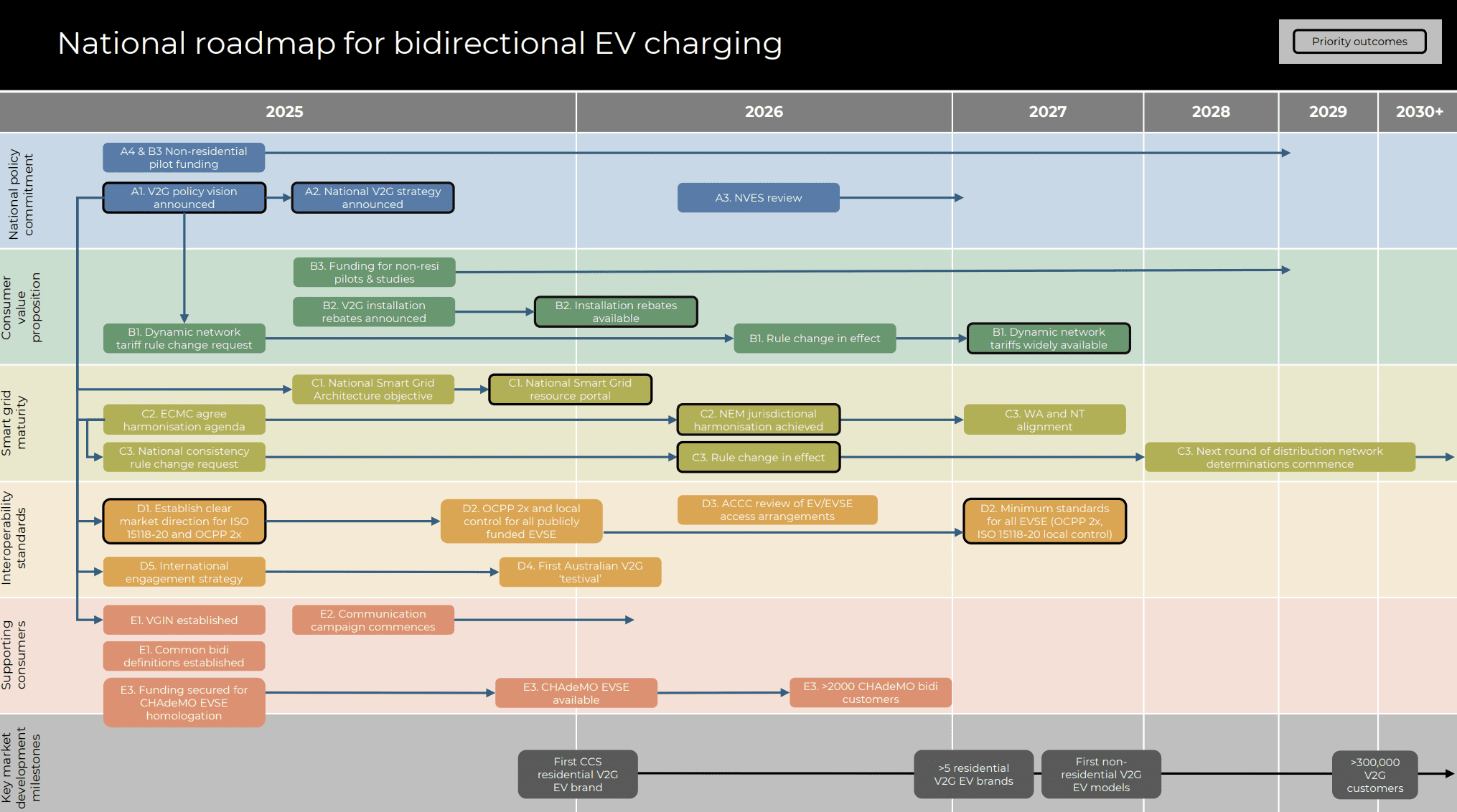
The National Roadmap recommends action begin this year to get moving on bidirectional charging.
The report sets out a vision for bidirectional charging to be “readily available to provide high-value services across the Australian economy by 2030, with several products available by 2027”, envisioning that hundreds of thousands of households could be using it to reduce their power bills by 2030, and millions by 2040.
That’s exciting news for those millions of Australians in 15 years time, but a long way off for those driving around EVs that use the CHAdeMO charging connector and are already capable of bidirectional charging.
The report estimates that 30,000 V2G-capable Nissan LEAFs and Mitsubishi Outlander PHEV customers in Australia will not be able to access bidirectional charging that meets Australian grid codes, noting that “some of these customers purchased these vehicles due to their bidirectional capabilities and they have been left stranded by failures in our (AS/NZ 4777.2) standards development and product certification frameworks”.
With the Combined Charging System (CCS) connector emerging as the dominant charging option in Australia, the report warns CHAdeMO is likely to be phased out in the coming years, so the bidirectional charging strategy should focus on CCS.
The roadmap however recommends that industry explore options for targeted support to “legacy” CHAdeMO owners to give them the ability to undertake V2G.
Dive Deeper
Read the full roadmap on ARENA’s dedicated webpage, where you’ll also find the agency’s V2G energy market modelling report.
Want to be ready to capitalise on the benefits of using your car as a home battery? Take a look at our guide on how bidirectional charging works, which vehicles are capable and what else you need.

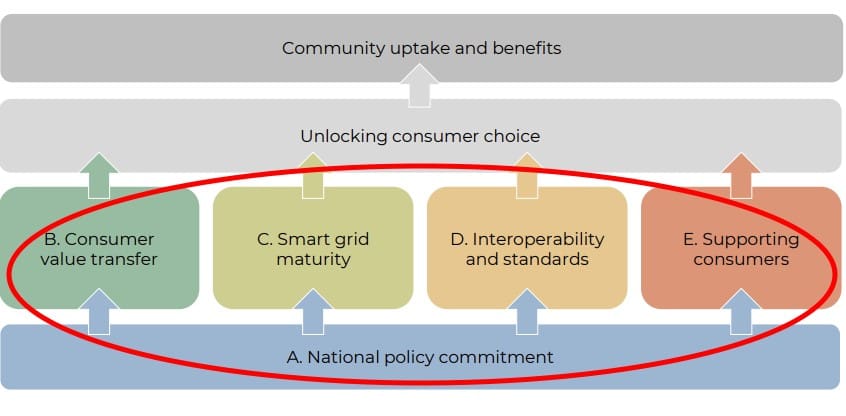
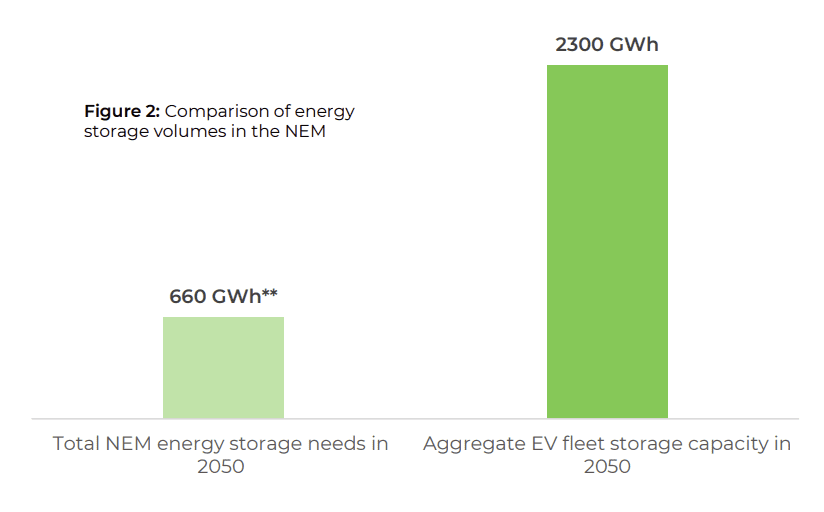
 RSS - Posts
RSS - Posts


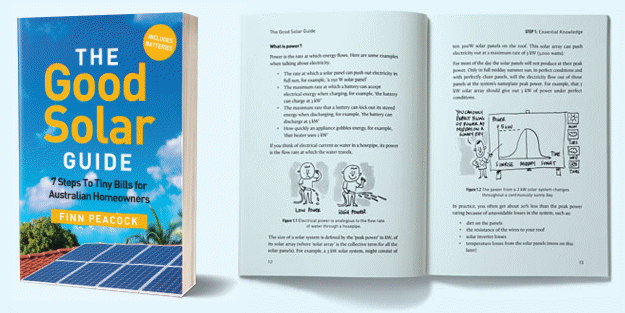
Rocket science. Battery in car connects to inverter connected to house switchboard. Trust Australia to over complicate and over legislate it as always.
Under no circumstances would I ever let the NEM take control over my house or car battery and equally I would never let the house drain the car.
I know there’s plenty who’ll see this as a great benefit but let’s see what their reaction is when their car doesn’t have enough charge to get them to their destination!
One of the primary reasons for investing in batteries, EVs and solar is to reduce and ultimately eliminate your dependency on the NEM. Might take a few years but every step delivers benefits.
I don’t agree on both premises.
Your second premise: My primary and only at the time reason for installing a three phase good quality 9kw solar array was mainly about the increasing cost of electricity and the benefits of FIT. It was and still is a very good result as I still get substantial FIT amounts – last month $120 excess. I was not nor am I now concerned about installing a stand alone battery or particularly concerned about grid outages.
Premise 1: These V2G systems can be set with parameters and use predictive algorithms based on usage so as to only use a part of your battery capacity (your car battery will be much larger capacity than a typical house battery) and topup your battery before you come out next morning to drive it. And you can just stop it using your battery at all if you may need to leave early or are going on a longer trip than usual and are concerned about it. Unless the usage/recharge is set incorrectly then you are highly unlikely to have a problem.
I would disagree. By using the car as V2H/ V2G you will not drain the car battery (unless you don’t charge it for few days). My car has 80KW battery and I have 50KW Solar battery. During the summer months when we use more electricity we are using about 70% of the Solar battery over night. I’ll be very happy to have the car as an option to use it as a “generator” in case of emergency. Fully charge battery let me drive for 3-4 days at least.
Car batteries are cheaper and will become even cheaper in near future. I just hope that we the consumers will be given more options to use the available technology especially when the feed in rebates are constantly dropping…and this is another reason not sending electricity back to the grid.
Lucky you, with a 50kW home batttery. You are among a very rare group. Most have 25% or less of your home battery capacity
Doing a quick calculation, one day of the car left in the driveway during the day plugged into solar gives me a full week’s commute AND close to all I need overnight. And chargers are smart – and will be smarter – and won’t drain the car beyond what it needs to drive depending on the day of the week if things are a bit different.
I for one cannot wait for V2H capable cars – imagine, if the govt subsidised bidirectional chargers and mandated all new EV to have v2h as a minimum, then you’d see amazing take up.
But – yeah. Wouldn’t trust the NEM far as I could throw it.
Can anyone explain why CHAdeMO users won’t be able to access these benefits, when just the other day I was reading that it’s a significant step closer with Mitsubishi’s agreement with V2Grid? Recent Outlander purchaser…
It will start at .36cents feed-in and end up at pay to feed-in. All the while offshore energy companies who pay no tax in australia will offshore the profits. https://michaelwest.com.au/top-40-tax-dodgers-of-2023/
With Victoria’s proposed FIT of 0.04c/kWh from 1Jul25, I’m not sure that it would make much financial sense for anyone in Victoria to permit their EV (or home batteries) to discharge into the grid, particularly if they have to pay >500 times that kWh price to get that energy back from the grid.
Hi Henry,
With retailers like Amber you can sometimes make handsome profit, just tonight is South Australia there was a 43°C day and a cloud bank rolled over Adelaide at 6pm curtailing solar production during the evening peak. This hour or two saw basically every generator available turned on, and the spot price would make discharging your car good for the network and for your bank balance.
Thanks Anthony,
I appreciate your comment and specific example.
Now I am wondering (when using Amber as the Electricity retailer), whether one can use the software settings (or a specific App) to ensure that feed-in (solar, battery, vehicle) only occurs if the dynamic FIT price is greater than a specific value… If so, this would alleviate my concerns of ‘being taken for a ride’ with respect to pricing to/from the grid.
There is, of course, the ‘greater good’ consideration that could be assisted by a more distributed network, with both home batteries and V2G feed-in for network stabilisation helping in this goal.
Hi Henry,
Amber have a couple different versions that are pretty user friendly. You need to use hardware that Amber have already done a specific integration for. Sadly there’s no standard interoperability program, so you’d have to use a brand that Amber support. Or possibly a device connected via CatchControl or Switchdin.
If you have more apetite for doing it yourself and being in more control there’s also a retailer called LocalVolts. You may need some help to navigate the way it works but there are people who do that.
Two points worth noting, Amber provides you access to the wholesale market rates as an energy retailer for both consumption and feedin. The very low ( $10/ kWh). You don’t need any special hardware to access the rates.
Amber also have an optional product called SmartShift that control your battery to export when the feed in prices are high and charge your battery when prices are low. This can be your fixed home battery but also once the standards are settled your V2G EV as well.
You don’t have to use the SmartShift product and can have your own Home Energy Management system where you have local control. If you want to say avoid consumption from the grid and only export from the V2G EV when the export price is > $1/ kWh you can.
I am hoping that BYD & others that offer V2L might be able to up-date their vehicle firmware to allow V2G. I can see no reason that a Vehicle Isolator system that both frequency matches & supplies isolation should be easily designed. Even if one was limited to the V2L capacity (often 3.5Kw) that would be enough capability to either grid feed, or manage peak demand of a site, particularly where there is multiple vehicles connected.
I feel that Home Assistant (an Open-Source Home Management system), might at some time allow intelligent management of EV bi-directional charger. This could allow the vehicle to be charged at times of low grid cost, or excess PV availability. At times the Grid demand is high, & the feed-in offer is reasonable, the software could sell power to the grid. This could be dynamically managed by the Home Assistant system (once suitable software is developed).
I use Home Assistant today to optimize my household energy consumption, when to charge & discharge my batteries, including V2G via OCPP as well as my other household loads; pool, aircon, hot water, …
https://youtu.be/G8hr0otB-pk
Aren’t there CHAdeMO to CCS plug adaptors already on sale, just for charging flexibility for legacy plug owners? Then the problem is non-existent, I would imagine?
EV range is not so generous that many will risk amplifying range anxiety just to power someone else’s pool heater, HWS, or toaster – unless the (nighttime) FiT *is* generous. Energy retailer greed seems likely to cause the entire program to abort, unless corporate mindset changes dramatically.
It is undeniable that gridscale storage, in shipping containers or cars, can displace a lot ofCO₂ emissions – much needed as that increased by0.8% in 2024. With 18 of the last 19 months over +1.5°C global heating, and January 2025 at +1.75°C, according to Copernicus (EU agency), I figure it’ll hardly take 10 years to cross +2°C, with albedo reduction due to ice melt and loss of low cloud cover adding to increased CO₂. (1.25 W/m² + 4 W/m²)
The very real benefit of V2G/V2H might just turn out to be high levels of local energy storage, close-coupled to rooftop solar, granting a significant level of energy self-reliance as the rate of high voltage pylons being storm-flattened increases well above recent levels. Regional and household self-sufficiency allows more time for reconstruction in the short term, and undergrounding in the long term, as atmospheric energy levels go off the charts. (Yeah, I know, it’ll take a couple of decades for that to hurt often.)
Apparently, battery upgrade retrofits can be performed on some BEV models, to give enhancements, such as increased battery capacity and thence, extended range, such as, for example, the original Nissan Leaf models, having their range extended from 117 km to 300km (https://ozelectricvehicles.com.au/pages/nissan-leaf).
So, why can the BEV manufacturers not develop upgrade retrofit kits, to enable their dealerships to retrofit enhancements, such as adding/increasing V2L capacity (some BEV models currently have 3.6kW V2L, some have 2.2kW V2L, and, some have no V2L capability (such as vans that are not so good for tradies, due to their lack of V2L) ), and, adding V2H capability?
If all BEV models would have at least 3.6kW V2L, it would optimise having a HOEM device installed (https://www.solarquotes.com.au/blog/hoem-review/), which, at 15A, should be able to fully use a 3.6kW V2L capacity, and, if the HOEM people would have a 32A connection facility available, it should be able to use up to 7.6kW V2Lcapacity.
So, to me, it seems reasonable and logical, for BEV manufacturers to offer, through their dealerships and/or service agents, provision to retrofit enhancements such as battery capacity upgrades, and, V2L upgrades, and, v2H functionality.
Simple.
It seams reasonable enough, and, logical, if they have any sense of innovation and creativity.
The simple answer is probably because they are in the business of selling cars, not upgrading them, and given all the costs of putting such a process in place including training, parts supply, meeting legislative requirements, warranty and support etc etc plus limited demand, it would be lots of hassle for little money.
Much the same reason ICE manufacturers don’t offer performance upgrades etc.
Being able to use an EV as a battery for my home would make it a certainty that my next car would be an EV and even bring forward the change in car.
It would also see us swap from gas to electric for hot water and stove top.
Ok so I probably don’t know what I’m talking about but My solar panels provide power to the house, charge the battery and when the battery is charged sends it off to the grid. Couldn’t the Car battery connect in a similar way.
Bidirectional DC energy transfer between an EV battery at 400 or 800 Vdc, and a domestic battery at (nominal) 48, 72, 144, or higher voltage, requires a sophisticated bidirectional DC-DC converter with buck-boost topology. Sigenergy seems to have one in their product range, but it”ll only handle their battery voltage, simplifying matters significantly. (I’ve read that it handles DC charging.)
While it it’ll be of the order of 5-8% less efficient (at rated power), the double conversion (DC-AC-DC) of AC charging the EV has the benefit of being commercially viable, due to using standard products.
In the other direction, V2G is single-step, with the EV’s on-board inverter converting straight to grid voltage and frequency. Stuffing the energy into the domestic battery instead, and only then going to grid via the battery inverter would be a lossy long way round, exacerbated by battery charge/discharge losses.
The difference between theory and practice is often much greater in practice than it is in theory. (As Boeing Starliner and Blue Origin tend to demonstrate, amongst others. Even Spacex blows up a lot of stuff, to discover the difference.)
Ok, so I just want a simple, but smart switching V2H system for EV charging and home use / blackout backups . EV will be garaged available for solar charging 50-70% of daylight hours. Microinverter solar system is 11.3 kw (only have single phase power; and in SE Qld).
So when can I do it and what is best system
Following with great interest and frustration that Australian governments are all so incredibly slow doing anything at all for good cheap energy and the climate.
I’m concerned about climate change, energy and production costs (of everything) which could be greatly reduced with renewables and coherent smart networks. But it’s all just a mess commanded by selfish profiteering gas interests that own most of the large electricity retailers. The infrastructure and retailers should never have been privatised.
Many thanks